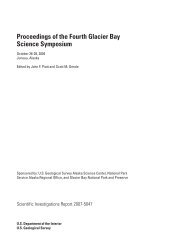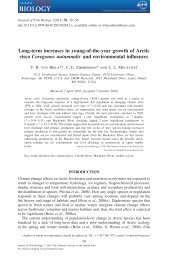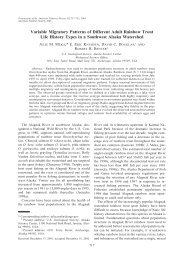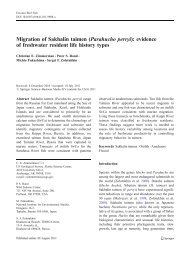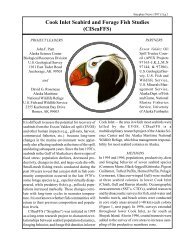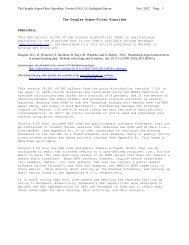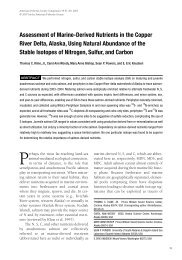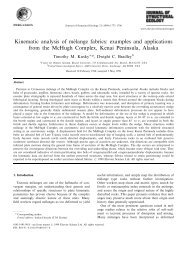Mexican native trouts: a review of their history and ... - Webspace
Mexican native trouts: a review of their history and ... - Webspace
Mexican native trouts: a review of their history and ... - Webspace
You also want an ePaper? Increase the reach of your titles
YUMPU automatically turns print PDFs into web optimized ePapers that Google loves.
302<br />
sister to Río Mayo trout <strong>and</strong> hatchery-reared rainbow<br />
trout. While this can essentially be viewed as an<br />
unrooted network <strong>of</strong> relationships, it is clear that<br />
Apache <strong>and</strong> Gila trout are closely related to the O.<br />
clarkii <strong>and</strong> O. mykiss groups as well as to the <strong>Mexican</strong><br />
<strong>trouts</strong>; unfortunately, these authors did not include<br />
<strong>Mexican</strong> golden trout in <strong>their</strong> analysis. Samples <strong>of</strong><br />
Baja California rainbow were used as an outgroup<br />
by Berg (1987) <strong>and</strong> Berg <strong>and</strong> Gall (1988) to infer<br />
the evolutionary genetics <strong>of</strong> coastal rainbow trout (O.<br />
m. irideus). The Baja California rainbow is distinguished<br />
from other coastal rainbows by the presence<br />
<strong>of</strong> the Ck-2 (115) allele. In an unpublished work on<br />
Baja California rainbow trout, Pister <strong>and</strong> collaborators<br />
identified different frequencies <strong>of</strong> Ck-2 (115) allele,<br />
from 0 to 50%, in three populations sampled. These<br />
authors compare Baja California rainbow with the Río<br />
Mayo trout, where the Idh-1, 2 (100) <strong>and</strong> Palb-1, 2<br />
(105) alleles were synapomorphic <strong>and</strong> delineated these<br />
taxa as discrete lineages. Their analyses supported a<br />
closer relationship between coastal rainbow trout <strong>and</strong><br />
Baja California rainbow trout than between either <strong>of</strong><br />
these <strong>and</strong> the Río Mayo trout. More recent molecular<br />
analyses <strong>of</strong> Baja California rainbow trout using<br />
mtDNA <strong>and</strong> DNA microsatellites confirmed this close<br />
genetic relationship between coastal rainbow <strong>trouts</strong><br />
<strong>and</strong> Baja California rainbow, but also documented<br />
unique dominant alleles for three nuclear microsatellites<br />
in Baja California rainbow trout (Nielsen,<br />
1997; Nielsen et al., 1997; Nielsen et al., 1998).<br />
Collections <strong>of</strong> <strong>Mexican</strong> <strong>trouts</strong> from the early<br />
1990s made by some <strong>of</strong> us (Table 1), while largely<br />
unvouchered in museums, included fin clips that<br />
were provided to one <strong>of</strong> us (JLN) for microsatellite<br />
DNA analysis <strong>and</strong> sequencing <strong>of</strong> the mitochondrial<br />
control region (Nielsen, 1996; Nielsen, 1997; Nielsen<br />
et al., 1998; Nielsen <strong>and</strong> Sage, 2001) <strong>and</strong> have<br />
provided the most extensive database for relationships<br />
<strong>of</strong> <strong>Mexican</strong> trout species. Nielsen <strong>and</strong> collaborators<br />
(Nielsen et al., 1997) examined both the Río<br />
Mayo trout <strong>and</strong> Baja California rainbow trout. In <strong>their</strong><br />
unrooted neighbor-joining analysis <strong>of</strong> DNA sequence<br />
data, the latter taxon was linked with California<br />
steelhead <strong>and</strong> McCloud River rainbows, whereas the<br />
former taxon was very divergent from the remaining<br />
rainbows, steelheads, <strong>and</strong> California golden trout (O.<br />
aguabonita or O. mykiss aguabonita). Microsatellite<br />
data from the same specimens identified the former<br />
as most similar to either California golden trout or<br />
steelhead, while the latter was always most similar<br />
to Little Kern River golden trout <strong>and</strong> some California<br />
steelheads. Later work by the same group (Nielsen<br />
et al., 1998) included more taxa from the rainbow<br />
group, various cutthroat taxa, <strong>and</strong> some Pacific salmon<br />
species. In a neighbor-joining analysis <strong>of</strong> control<br />
region mitochondrial sequences, if rooted with Pacific<br />
salmon species, there is a monophyletic O. clarkii<br />
lineage sister to a monophyletic group inclusive <strong>of</strong><br />
an Apache <strong>and</strong> Gila trout lineage that is sister to an<br />
essential O. mykiss lineage. Within the latter group,<br />
Baja California rainbow trout is a member <strong>of</strong> a wellcorroborated<br />
group that also includes coastal rainbow<br />
<strong>and</strong> Sacramento redb<strong>and</strong> (O. mykiss stonei). The trout<br />
from the Río Yaqui system were found to be part <strong>of</strong><br />
a larger coastal rainbow clade. These relationships are<br />
inconsistent with those observed by Stearly (1992) <strong>and</strong><br />
Stearley <strong>and</strong> Smith (1993) using morphological <strong>and</strong><br />
chromosome data, wherein O. clarkii formed the sister<br />
group to a clade where the Apache + Gila trout clade<br />
was sister to a clade inclusive <strong>of</strong> Pacific salmon species<br />
<strong>and</strong> various forms <strong>of</strong> O. mykiss, including Río Yaqui<br />
trout <strong>and</strong> Baja California rainbow trout. Furthermore,<br />
in <strong>their</strong> analysis O. mykiss was never observed to be a<br />
monophyletic group. Finally, adding data on <strong>Mexican</strong><br />
golden trout to the molecular data on <strong>Mexican</strong> <strong>trouts</strong>,<br />
Nielsen <strong>and</strong> Sage (2001) compared populations from<br />
the Mayo, Yaqui <strong>and</strong> Guzmán systems with the<br />
<strong>Mexican</strong> golden trout. They found that Mayo <strong>and</strong><br />
Yaqui <strong>trouts</strong> are as different from coastal O. mykiss,<br />
as is <strong>Mexican</strong> golden trout. The Guzmán populations<br />
were shown in that analysis to be very closely related<br />
to the Río Bavispe trout.<br />
Histories <strong>of</strong> habitats <strong>and</strong> threats<br />
Prehistoric anthropogenic alterations. Habitats<br />
occupied by <strong>native</strong> <strong>Mexican</strong> <strong>trouts</strong> have a long <strong>history</strong><br />
<strong>of</strong> human modifications. Obviously, prehistoric<br />
peoples long inhabited these areas (Lumholtz, 1902;<br />
Sauer, 1935). We do not here pursue details <strong>of</strong><br />
<strong>their</strong> influences on aquatic systems, but remnants<br />
<strong>of</strong> ‘trincheras’ <strong>and</strong> check-dams hypothesized to<br />
be erosion control structures (Doolittle, 1985)<br />
remain evident today in many areas, including trout<br />
streams (Leopold, 1940), providing evidence <strong>of</strong><br />
<strong>their</strong> former activities <strong>and</strong> purposeful stream habitat<br />
modifications. Canals were also in use in the general<br />
region (Doolittle, 2000), though primarily at lower<br />
elevations.<br />
Climate changes. Whether anthropogenic or not, there<br />
are a number <strong>of</strong> indications that today’s climate in<br />
the region is on average warmer <strong>and</strong> drier than it was




